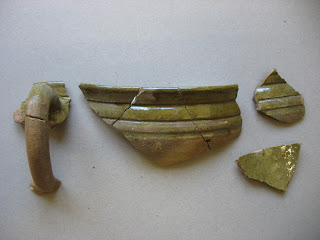A very hot day today, so we had the pot washing crew under cover.
The base of a 'Bellarmine' jug.
The body of a Bellarmine jug.
The ditch produced a fine collection of stone balusters.
This fine carved stone is of the 'cup & egg' design. It would have been in a prominent postion.
The large stone is a particularly fine example.
At the moment it cannot be said that we have the cellar or the corner of the house definitively. We plan to open another trench soon to answer this question. This photo is of a wall (bottom right) and a limestone slab with a petrified wave pattern. is this a floor?

































